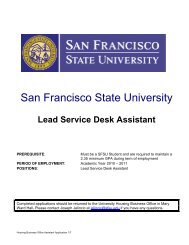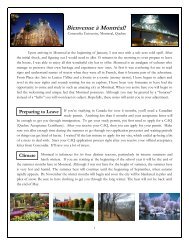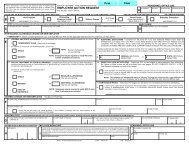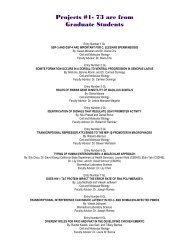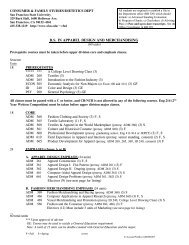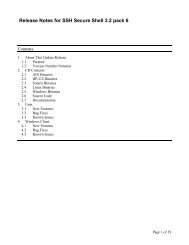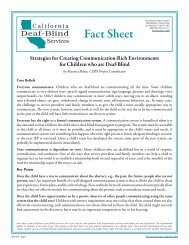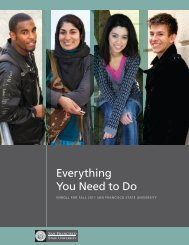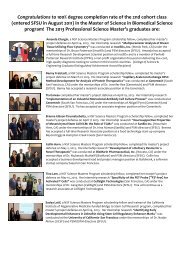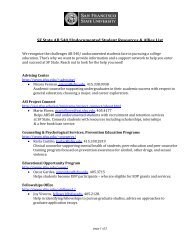reSources Spring 2008 (Vol. 13, No. 2) - San Francisco State ...
reSources Spring 2008 (Vol. 13, No. 2) - San Francisco State ...
reSources Spring 2008 (Vol. 13, No. 2) - San Francisco State ...
Create successful ePaper yourself
Turn your PDF publications into a flip-book with our unique Google optimized e-Paper software.
http://www.sfsu.edu/~cadbs/News.html<br />
California<br />
Deaf-Blind<br />
Services<br />
(Sharing Information to Improve Your Children’s Learning Experiences at School, continued from page 6)<br />
4. Does your child have medical/health related issues? Is<br />
she taking any medications that could impact her level of<br />
engagement in the classroom? If she doesn’t eat regular foods,<br />
what is her diet and your goals for eating? Does she have<br />
problems napping or sleeping through the night? Are there<br />
special provisions in the case of medical emergencies that the<br />
school staff should be aware of?<br />
Communication<br />
Most children who are deaf-blind have challenges with<br />
receptive and expressive communication. Many have difficulty<br />
expressing their wants and needs, socializing with and<br />
understanding others, and learning new concepts in school.<br />
Communication is involved in every activity throughout the<br />
day and with every person your child interacts with. The ways<br />
in which your child communicates might be clear, or may need<br />
to be explained so that she can be understood by others. Give<br />
service providers the clearest description you can about how<br />
your child communicates, especially communication strategies<br />
you use at home.<br />
Considerations:<br />
1. How does your child communicate through behavior? How<br />
else does your child communicate? Through gestures, signs,<br />
words, or a combination of these?<br />
2. Be as specific as you can when sharing information about<br />
communication. Your child’s communication system is very<br />
unique to her, so the more information the better.<br />
3. Whenever possible, it is very helpful to provide information<br />
about your child in writing. Written information about your<br />
child’s communication system can be shared more easily and<br />
accurately across team members at school.<br />
Ideas for sharing information can vary depending on the<br />
particular child and specific needs. What I’ve included<br />
here are just a few of the types of information you may want<br />
to share with your child’s service providers. Channels of<br />
communication need to be open throughout the year so that<br />
school staff is aware of new information that may help your<br />
child in school. The most important thing is to share this<br />
information so that you minimize time lost in order to move<br />
your child’s education forward.<br />
Job Opportunity at CDBS!<br />
The <strong>No</strong>rthern California CDBS Family<br />
Specialist position is currently vacant, as<br />
a result of Jackie Kenley’s retirement last<br />
Fall. Anyone interested in applying for the<br />
position should visit the <strong>San</strong> <strong>Francisco</strong> <strong>State</strong><br />
University Human Resources website and<br />
search for job ID #: 1932<br />
Are you<br />
interested<br />
in teaching?<br />
Find out about an innovative<br />
new teacher training program in<br />
deaf-blindness. Visit:<br />
http://www.sfsu.edu/~spedcd/<br />
Comments? Questions?<br />
Email the author: gloria.gil@gte.net<br />
v<br />
University–CDBS<br />
Partnership Project<br />
California Deaf–Blind Services <strong>reSources</strong> Winter 2009 <strong>Vol</strong>. 14, Number 1 page 7



